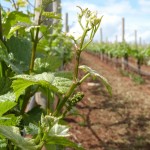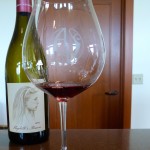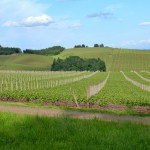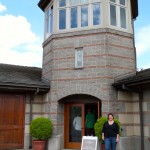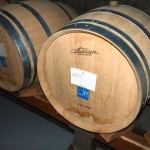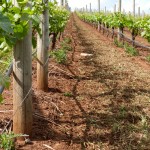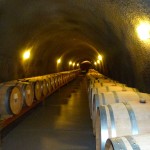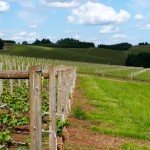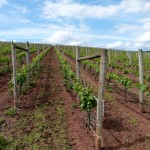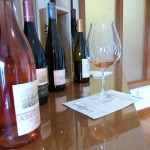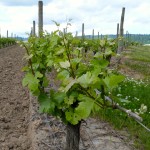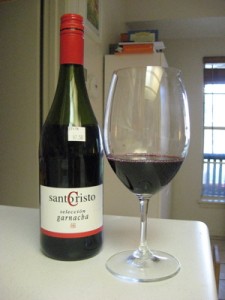Tom and I took a little overnight trip to the Dundee Hills, our first since having kids over 5 years ago. Tasting notes to come (when I find my notebook), but here’s some of the beautimousness.
Category: regions
 The clever folks at Good Cheap Vino clued me into the fact that Cost Plus World Market is having a white wine sale all month long. As Jeff Lefevere at Good Grape writes in his post about World Market, it’s a good place to find decent, reasonably priced wine that is terribly likely to have a little class. I don’t think they have the best deals in Austin, for the record, but this particular sale brought them down about a dollar a bottle lower than comparable stores… on most things.
The clever folks at Good Cheap Vino clued me into the fact that Cost Plus World Market is having a white wine sale all month long. As Jeff Lefevere at Good Grape writes in his post about World Market, it’s a good place to find decent, reasonably priced wine that is terribly likely to have a little class. I don’t think they have the best deals in Austin, for the record, but this particular sale brought them down about a dollar a bottle lower than comparable stores… on most things.
Plus, I could bribe the toddler to stay in the cart while I stocked up with a small blue froggie. (I’m virtually certain Specs does not stock bath toys. Hint, hint, y’all.) And yes, I take my preschooler wine shopping. How else is she going to learn?
So Good Cheap Vino was interested in the Bogle Chardonnay ($8.99), Pacific Rim Riesling ($9.99) and Hess Sauvignon Blanc ($11.99), among others – which definitely piqued my interest. However, once I made one round (and with the family budget in mind), I set myself the challenge to “get down, girl, go ahead, get down.” And whaddyaknow if I didn’t walk out of that store with 8 bottles of white for $60 (plus $3 for the above-pictured blue froggie. He goes “puff-puff-puff.” It’s pretty awesome.)
But the most exciting thing… do you want to know the MOST EXCITING THING? The thing that will probably get me BACK to Cost Plus World Market, heaven help me?
Dude. Dude. This $3.99 Rene Barbier Mediterranean White. It’s sick. I want to bathe in it.
And it’s only $3.99, SO I CAN AFFORD TO.
 Lemon yellow in the glass. Lemon/granny smith nose, floral notes and a whiff of the seaside. Bright and lively on the palate with just a feint of sweetness before the refreshing lemon/lime flavors and the edge of the edge of petillance chase that off. Nice medium weight, and a respectably long finish of mineral and (hey, what a coincidence!) lemon peel. Really delicious. Yum.
Lemon yellow in the glass. Lemon/granny smith nose, floral notes and a whiff of the seaside. Bright and lively on the palate with just a feint of sweetness before the refreshing lemon/lime flavors and the edge of the edge of petillance chase that off. Nice medium weight, and a respectably long finish of mineral and (hey, what a coincidence!) lemon peel. Really delicious. Yum.
Rene Barbier is a pretty respected winery in Spain (owned by the Ferrer family – they of Freixenet – since 1984), and from what I can tell their Mediterranean White (also comes in Rose and Red, btw) is Made For the USA. Which, um, yeah – cool with me. I’m going to drink the crap out of this wine over the summer.
The region spouting this tasty jooce is Catalunya, which is the most northeastern area of Spain, on the Mediterranean. The grapes in the wine are a blend of Xarel-lo, Macabeo, and Parellada – all grapes used in Spain’s signature sparkling wine, Cava.
The alcohol level is higher than my other go-to summer wine, Vinho Verde, at around 11.5%. Which is fine, since this is a lovely food wine – anything you can imagine squeezing lemon on will pair well with this. And the food will soak up some of the alcohol you’ll have ingested when you realize that somehow you’ve drunk half a bottle all by yourself.
When you go get some – and I encourage you to do so in the next couple of weeks, before the price goes back up to $5.99 – please don’t buy it all. I’m almost done with this bottle already.
Here’s how it went, today at 5:50: “Hm, I guess while the kiddo is watching a special treat TV show before dinner, I’ll surf around wine blogs for a sec.
Wait, is it Wednesday?
Wait, isn’t there a WBW coming up?
Wait, is today the effing 16th?
GD it, I was going to drink that crisp white in the fridge tonight.
Hell.
Do I even have any Rhone varietals in the closet?
Cotes du Rhone, Morgon, Bourguiel… Oh! I forgot about this little Garnacha.
Campo de Borja, cool. $7.50, easy to open for no other reason than blogging.
Plus, that’s all I’ve got that works.
OK, let’s crack it open, snap a photo and get to writing.”
So I poured out a glass and got started 10 minutes before dinnertime.
This is a pretty little wine; purple in the glass, with ruby-red tints, it smells of raspberries and mint. Tart on the palate, with pepper and flavors of unripe blackberry now, as well as a hint of… tar? Then the tannins come and chase everyone out of the room; the finish is pretty long, with cane berry flavors re-emergent and lingering. A decent level of complexity for this wine I spent $7.50 on at Austin Wine Merchant, though more of a quaffing wine and less of a food wine, to my mind at least.
I am confident of the latter statement because I happened to make barbecued chicken thighs, anasazi beans and baked sweet potato fries tonight for dinner, which was, I thought, fortuitous. I like Rhone varieties with barbecue flavors – Syrah especially, of course – but Spanish Garnacha can be so heavily extracted that they can sometimes pull off that sweet fruit/charred notes match.
With the Santo Cristo, though, the barbecue sauce on the chicken really brought out the tarry notes in the wine. Maybe if there were more acidity in the wine to offset the tomato… but the creamy sweet potatoes and beans didn’t match very well either. If I knew then what I know now about this wine, I’d put it with a fattier meal, like a grilled sirloin, or maybe just not tricky-dick barbecue sauce.
Garnacha is my ticket in to Wine Cast’s Wine Blogging Wednesday #71 because it is the Spanish version of Grenache, that staple grape of the Southern Rhone. Grenache/Garnacha is a high-producing vine that is known for its spice, ample berry fruit and high sugars (which translate to high alcohol). When the Spanish vinify their really old, old vines, however, the resulting Garnacha wine bears only superficial resemblance the French Grenache.
OK, so this is probably my worst WBW post ever. I did not plan, so I have not had time (had people over this evening after I got the kid to sleep, and it’s late – for me at least – now) to really research the producer or write a cogent breakdown of the region or the grape. I really like the Campo de Borja region for wines that drink way above their price tag, just so you know. And I am in favor of Rhone varieties wheresoever they are planted.
Drink Garnacha.
Scamp out.
I’m Baaaaaaaaack….
Did you wonder if you’d ever hear from me again? I wondered, too. I kind of thought I wouldn’t be back – that the Scamp was not motherhood-friendly. I’ve been blogging, off and on, at Careening and Gestating, and now at Wigglet McFancyPants. But it was pretty impossible to keep Scamping when I had no taste for wine while pregnant and then insufficient courage to risk wine drinking while feeding a colicky baby nothing but my breastmilk.
Colic? Ugh. Don’t get me started.
I finally started drinking wine again a month or so ago, almost more as medicine than for enjoyment. Returning to the Scamp with little money and less time to taste wine is going to be a challenge, but I hope that you, dearest reader, will suffer through it with me. I imagine that more than a few of the denizens of the Mystical Interwebs find themselves equally challenged, both financially and temporally.
On that note, here are tips for all those New Mother Wineaux out there:
1.) Drink cheap. exersaucers and convertible car seats and diapers and baby pools and rompers and, most of all, DAY CARE, has begun to act as a budget-eating virus on your life. Evidently, this doesn’t end for a long time. Once you start drinking wine again, you’re going to want to do it a lot, so don’t imagine that you’re going to be quaffing Sine Qua Non – or even Shafer – until the little tyrant is at least in high school.
2.) Drink simple. The last thing I want to think hard about after a long day of work, child ferrying, breast pumping, rushing through traffic, scraping leftovers into a semblance of dinner and getting the kid to FINALLY go to sleep… well, the last thing I want to puzzle over is a complex, hard-to-warm-up-to bottle of wine. The pleasures reserved for new parents are simple ones. Use your brain power to eke out more than 10 minutes to yourself every week.
3.) Drink food-friendly. If you’re breastfeeding, you’re probably going to be drinking a glass of wine with dinner. If you’re not breastfeeding, you probably need to multi-task and will be drinking a glass of wine with dinner. And since dinner in my household – I don’t know about yours; maybe you have Chateaubriand every night! – but since dinner in my household is a PBJ about twice a week, I stock my fridge with wine that’s high in acidity and low in tannin. As an example, Viognier + PBJ = 🙁
4.) Drink a lot. Ha! Just kidding. I figure that a glass of wine with dinner at night will, at worst, encourage the Wigglet to sleep better that evening. I have not done any research, internet or otherwise, so I am currently Making This Shit Up to the Nth degree. For the record, I hate Pump & Dump. It’s such a pain in the ass to express breast milk that I can NOT just throw it away. I’d rather exercise a little restraint. Especially considering that’s all the exercise I get these days!
I’ll be trying to give you a run-down of some of my favorite wines that fulfill all of the above guidelines. If this can help a wine-deprived soul up to her elbows in poop and spit up, all the better!
I represented Oregonians with a brief talk at last Monday’s Winebat tasting of Oregon Pinot Noir, and had a blast doing it. The wines all showed beautifully, and the resulting tasting was an orgiastic, olfactory delight.
Here’s a summary of the infotastic blurb I introduced the wines with:
“As with most areas in the US, winemaking in Oregon dates back to pioneer days and was halted by Prohibition. Oregonians waited over 30 years after the Repeal to get back to stomping the grape, though, and it was actually Californians who brought the impetus and the grapes to plant in the Willamette (rhymes with “damn it”) Valley in the late 60s and early 70s. A milestone for Oregon wine was when a Pinot Noir from Eyrie Vineyards won the Wine Olympics in 1979. Oregonian wineries, like those in Texas, tend to be small and family-owned.
The Willamette valley, home to the largest concentration of Oregon wineries, is located at roughly the same latitude as Burgundy, with cold, wet winters and warm, dry summers. No, it doesn’t rain all the time everywhere in Oregon. Pinot Noir makes up about 70% of the wine output of the state.” Or something like that.
Then I laid down a brief description of What You Might Be Smelling and Tasting and commented on how PN is well known for its uniquely silky texture. And we all set to the serious business of sniffing and sipping. I’ve listed the wines below in order of my preference, but really all of them were lovely business.
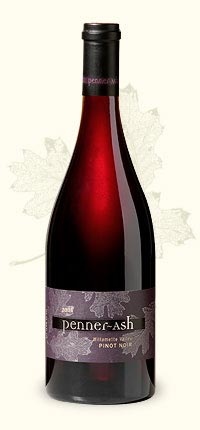 Bethel Heights Casteel Reserve Pinot Noir 2005, $50: Gorgeous minty, Bing cherry, lavender, mushroom and forest floor aromas. Bright, sweet explosion of acidity on the palate, with really integrated tannins and lovely Portobello and clove flavors. The texture is truly fine, solid but satiny. Extravagantly good.
Bethel Heights Casteel Reserve Pinot Noir 2005, $50: Gorgeous minty, Bing cherry, lavender, mushroom and forest floor aromas. Bright, sweet explosion of acidity on the palate, with really integrated tannins and lovely Portobello and clove flavors. The texture is truly fine, solid but satiny. Extravagantly good.
Penner Ash Willamette Valley Pinot Noir 2006, $48: Very fragrant, with mint and truffle, vanilla and strawberry syrup on the nose. HUGE on the palate, with bright cranberry and concentrated cherry cordial. Very intense, spicy tannins, and rich, unctuous, concentrated structure. Flamboyant, but sleek.
Benton Lane Pinot Noir 2006, $26: Candied cherry, vanilla, rose petals and over-the-top strawberry. Slightly on the astringent side, the palate has cranberry, earth tones and sharp-edged tannins, with a little Prince of Wales tea on the back end. Very structured.
A to Z Oregon Pinot Noir 2006, $19: Kind of a whang on the nose at first, but that blew off to show really distinct strawberry and cherry, with a really earthy palate of plum skin, crazy overflowing spice and ripe mushroom. The finish goes on and on.
 Erath Pinot Noir 2006, $19: Nutmeg and distinct strawberry cream cheese on the nose. Smooth and sensuous on the palate with black tea and bright cranberry cocktail. Sexy, sexy.
Erath Pinot Noir 2006, $19: Nutmeg and distinct strawberry cream cheese on the nose. Smooth and sensuous on the palate with black tea and bright cranberry cocktail. Sexy, sexy.
Solena Cellars Grand Cuvee Pinot Noir 2006, $25: There was this chewing gum in Mexico that came in the flavor “violet,” and this had that smell, kind of chemically flowers, along with some slightly charred truffle. Soft and supple on the palate, without much grip. Kind of mediciney.
I’ll be at the Winebat blind tasting tonight at Green Pastures, where we’ll be enjoying six Spanish reds and matching light apps for only $25. Coming?
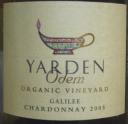 I received this wine as a sample for tasting. I’ve had Yarden before and enjoyed it, but that was a long time ago – before I had really started learning about wine.
I received this wine as a sample for tasting. I’ve had Yarden before and enjoyed it, but that was a long time ago – before I had really started learning about wine.
Bright gold in color. Nose of butter, honey, hazelnut and cream. Woodsy on the palate, with candied apple, tropical flavors and rounded creamy tones. Slight bitter astringency from oak tannins, a hint of copper penny minerality and a lingering finish of Golden Delicious apple.
 I was hoping that this might pair well with maple-glazed roast pork loin with rosemary that I had planned for that evening, and I whipped up some creamed spinach and creamy polenta with garlicky mushrooms. I rarely prepare Cooks Illustrated recipes, as they are usually complicated despite their relative perfection. This pork loin, however, looked quite simple and seemed to result in a minimum of pans to clean. Of course, I mucked that up for myself by making those two side dishes, but there you are.
I was hoping that this might pair well with maple-glazed roast pork loin with rosemary that I had planned for that evening, and I whipped up some creamed spinach and creamy polenta with garlicky mushrooms. I rarely prepare Cooks Illustrated recipes, as they are usually complicated despite their relative perfection. This pork loin, however, looked quite simple and seemed to result in a minimum of pans to clean. Of course, I mucked that up for myself by making those two side dishes, but there you are.
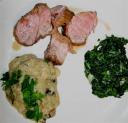 The Chardonnay took the pork easily, and the rosemary was felicitous, but the maple syrup glaze brings a candied element to the wine. The wine was divine with the creamed spinach; creamy flavors met buttery wine, and the spinach tasted clean but without bitterness. The polenta was an interesting pairing; the oak tannins quarreled with the corn flavors, but the parmesan was oddly OK with it all. It was kind of like the stereotypical Italian family, where yelling is the norm but no one takes it wrong.
The Chardonnay took the pork easily, and the rosemary was felicitous, but the maple syrup glaze brings a candied element to the wine. The wine was divine with the creamed spinach; creamy flavors met buttery wine, and the spinach tasted clean but without bitterness. The polenta was an interesting pairing; the oak tannins quarreled with the corn flavors, but the parmesan was oddly OK with it all. It was kind of like the stereotypical Italian family, where yelling is the norm but no one takes it wrong.
The Galilee region of Israel is the northernmost wine appellation in the country, and the coolest growing region. The Odem Vineyard has been farmed organically since 1998, and is located at an elevation of slightly under 4,000 feet.
Israel, of course, has been making wine since time immemorial. One big blip in this millenia of history was when Baron Edmond Rothschild aided a group of Jewish immigrants to Israel in 1882 by sponsoring their attempt to found a winery. They struggled for a while, but in the end Rothschild built two wineries in Israel. His son donated the wineries back to the growers cooperative in 1957.
Israeli vineyards started modernizing in the 70s, and now owe more to California than they do to France; this Chardonnay is certainly testament to that. Golan Heights Winery, which produces Yarden as well as two other labels of wine in Israel, is one of the houses that’s lead the charge to bring the entire industry up to world standards. I’d say they’re there.
Found this wine at the Cowboy Steakhouse in Kerrville, a city I rarely visit except during the Folk Festival. Fredericksburg is really my Hill Country dining destination of choice, but when I saw in Kerrville’s dining brochure that this restaurant had the most extensive wine list in the Hill Country, I just had to go.
Truth in advertising, y’all. I could have been more impressed by the food (my strip steak was correctly cooked to temp but could have been more much flavorful), but the wine list at the Cowboy Steakhouse is really impressively extensive. According to their website, they’ve got over 600 labels on the list, and that’s quite plausible based on the list I saw. They also have multiple verticals (a collection of the same wine from many different years), some dating back to the 80s. The Ferris family has been in the restaurant business since 1977, so I suppose all that collecting could have happened slowly and over time. At least I hope so, or I hope they have pockets as deep as Micheal Bloomburg.
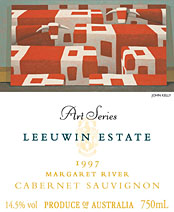 After dithering extensively over the pages and pages of wine available, I found a 1997 Cabernet from Leeuwin Estate in the Margaret River district. They make the best Australian white wines I’ve ever tasted, but I confess I had never been blown away by their Cab. Nonetheless, I was excited to find this aged red on the wine list for only $59.
After dithering extensively over the pages and pages of wine available, I found a 1997 Cabernet from Leeuwin Estate in the Margaret River district. They make the best Australian white wines I’ve ever tasted, but I confess I had never been blown away by their Cab. Nonetheless, I was excited to find this aged red on the wine list for only $59.
Great deep black ruby in color; little no brick red on the edges. First up in the glass, menthol, redfruits, pine tar and cassis show in the nose. The palate showed great smooth raspberry jam and a hint of red Swedish Fish. The finish of green tobacco and cigar box is remarkably smooth, with rounded, soft tannins.
As it opens up, a musky limburger aroma shows up and the menthol strengthens into eucalyptus and cedar. Some green olive scents are evident, as well. The palate develops into licorice and coffee, with kirsch, graphite, green pepper and black olive. The flavors are exceptionally well-integrated. With steak, even the smooth tannins recede, and a cocoa-cassis syrup element peeks around the corner.
Leeuwin Estate was part of Robert Mondavi’s attempt to break into the Australian wine region in 1972. Dennis and Tricia Horgan founded this winery, located in arguably the best wine region in the country, with Mondavi’s guidance. They have three labels: “Siblings,” meant for drinking young, “Prelude,” meant for drinking within a few years of release, and “Art Series,” meant for aging.
The winemaker’s notes predict an aging period of 7-10 years, but the 1997 Leeuwin Cabernet Sauvignon is in its prime at eleven years and counting. If you can find any (and it looked like the Cowboy Steakhouse had about 10 bottles left), I suggest you run, don’t walk, for a corkscrew.
Label image lifted from http://www.leeuwinestate.com.au/
This was my first Winebat blind tasting since I started coming off of the cedar fever, and at the end of the night I didn’t think I was really 100%, olfactory-wise. Damon really Brought It as far as wines in this tasting, and none of them really blew me away.
Since we were tasting wines from a region, rather than a single varietal, we did a flight of whites and a flight of reds. This was a neat exercise in blind tasting to detect varietal, and I did medium-OK considering my nasal handicap. Wines listed in order of preference within each flight:
So after some disappointing explorations of some smaller Austin wine shops, I finally took the time to really explore the Austin Wine Merchant, and I must say I was very pleased with what I found there! They have an exquisite French selection, some off-the-beaten path Italian reds, and they sell bin-ends for a tidy discount, which allows me to build a cellar with things I probably wouldn’t normally pick up. Why is it that $5 or $10 off a bottle makes it nearly irrisistible? Madness!
Another nice thing about the Austin Wine Merchant is that they actually have some reasonably priced bottles, which is sometimes hard to find in collector-oriented stores! I picked up this Domaine Andre Brunel Grenache, a Vin de Pays de Vaucluse, for only $5.99!
 I am not a Texas native. My husband is a 5th-generation Texan, and loves his state as only a Texan can. When we drive through the countryside, he’ll comment on how a certain famous battle happened in this town, or how that area was colonized by the Old Three Hundred. You have to drive a lot in Texas; I think it’s in the state constitution somewhere.
I am not a Texas native. My husband is a 5th-generation Texan, and loves his state as only a Texan can. When we drive through the countryside, he’ll comment on how a certain famous battle happened in this town, or how that area was colonized by the Old Three Hundred. You have to drive a lot in Texas; I think it’s in the state constitution somewhere.
If you don’t live here, you probably haven’t tasted a Texas wine. I know I hadn’t, until I moved to Austin. And there’s a good deal of wine to taste, really: Texas is fifth in U.S. wine production, after California, Washington, New York and Oregon. All in all, Texas makes about 1.5 million gallons of wine every year, and about 95% of it is consumed in Texas. Are we bad sharers? Well, it’s not like you’ve been asking for any.
